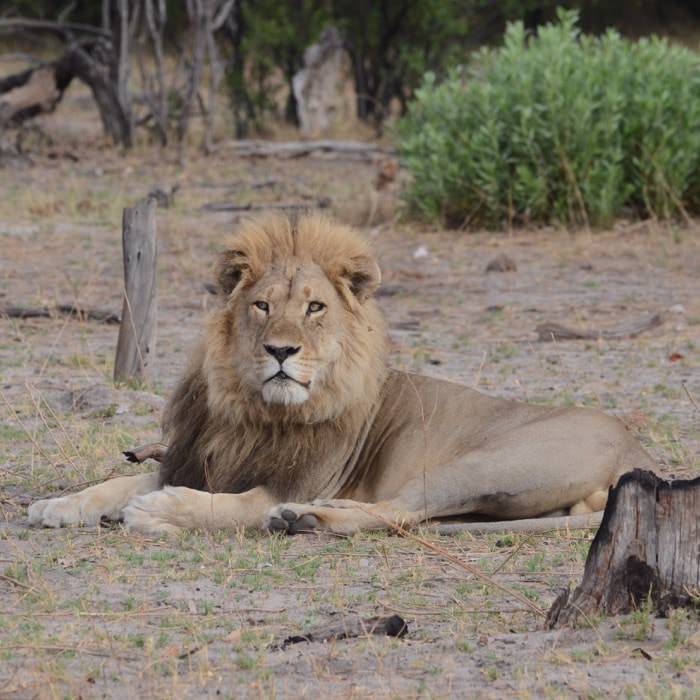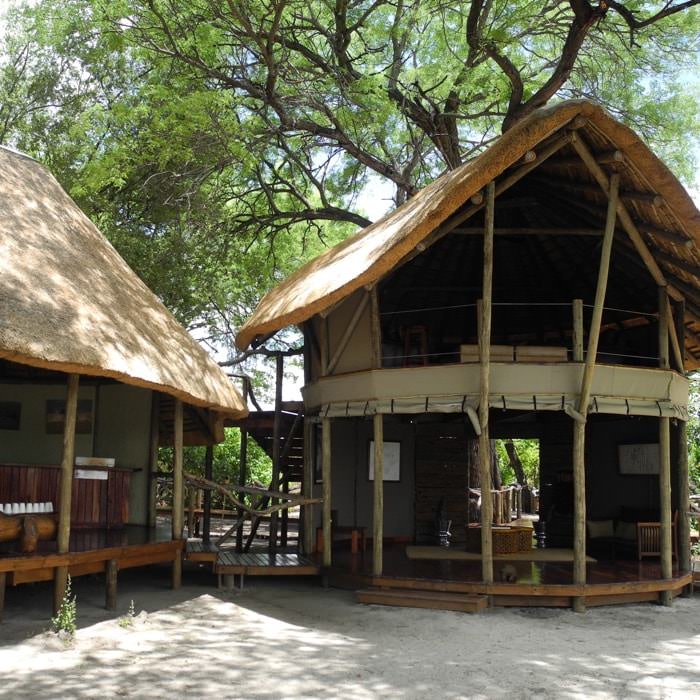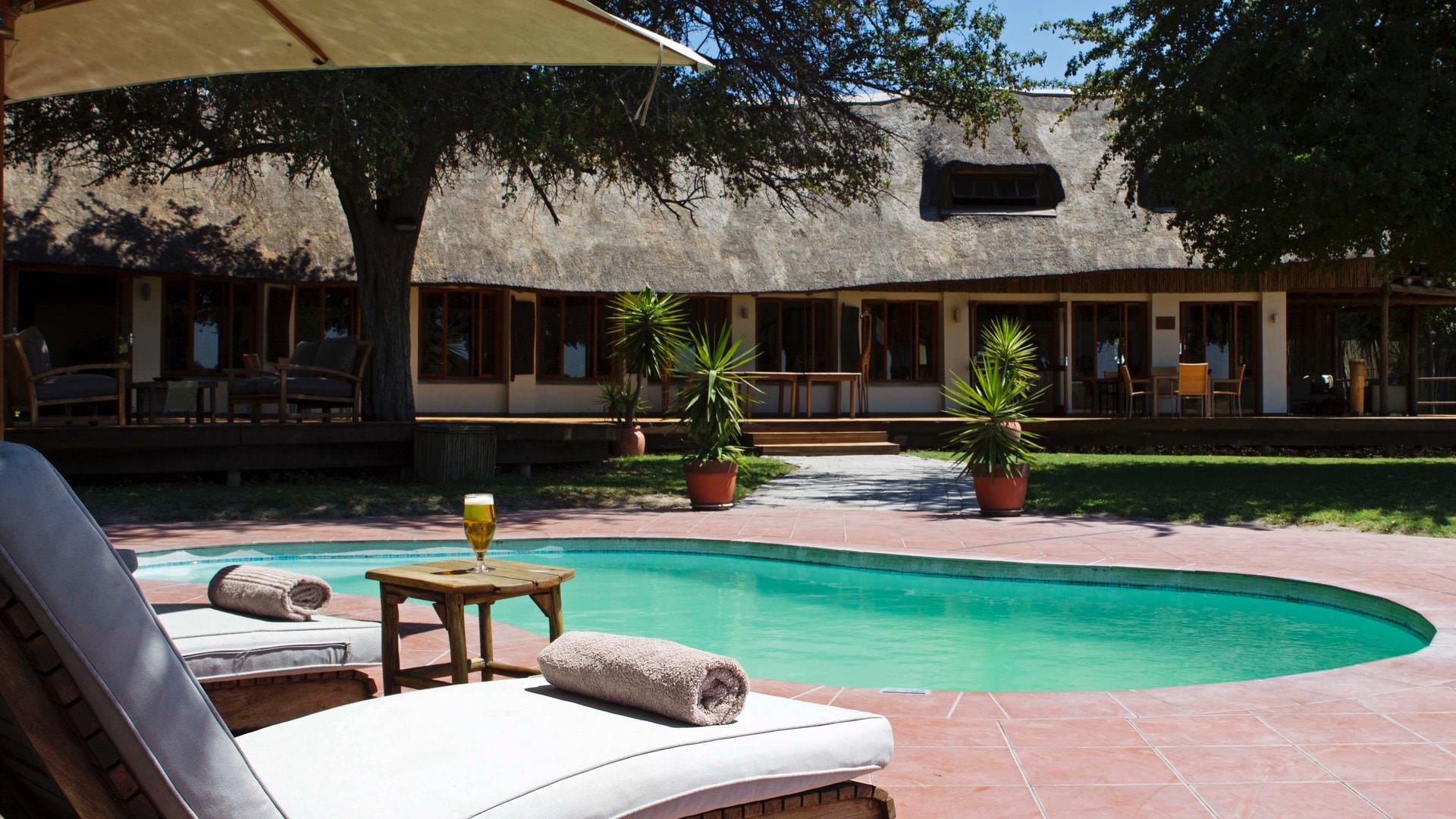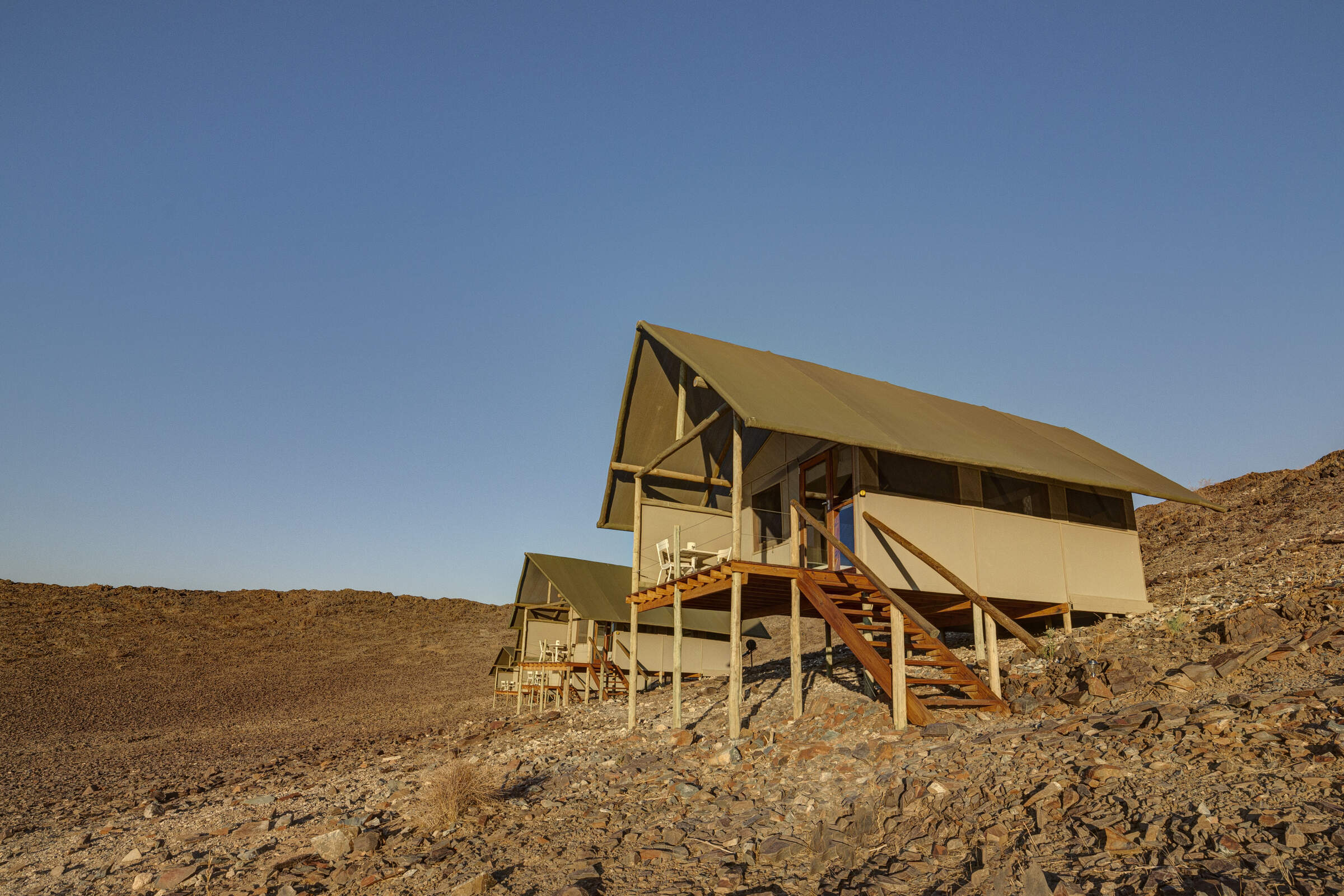About Hotel Helmeringhausen
Hotel Helmeringhausen lies in the small town of Helmeringhausen in southern Namibia.
It is an eccentric hotel which forms part of the 100km² Farm Helmeringhausen. Founded during the German colonial era as a farm this land became famous for breeding Karakul sheep.
This hotel from a bygone era has more of a lodge feel and makes for a convenient overnight stop to break the long drive between the Namib Naukluft National Park and Luderitz or the Fish River Canyon. It has been a few years since any of our team stayed here, so we are not sure what their service standards are currently.
Our view
This hotel from a bygone era has more of a lodge feel and makes for a convenient overnight stop to break the long drive between the Namib Naukluft National Park and Luderitz or the Fish River Canyon. It has been a few years since any of our team stayed here, so we are not sure what their service standards are currently.
Accommodation
22 Rooms
Children
Fine for children
Open
All year
Activities

Private activities
Traveller reviews of Hotel Helmeringhausen
17 real, un-edited reviews from Expert Africa's travellers.
Arrived 14 Sep 2019, 1 nights
"Hotel shows sign of aging"
Overall rating: Average
Arrived 3 Oct 2018, 1 nights
"An oasis of calm"
Overall rating: Excellent
Arrived 24 Jun 2018, 1 nights
"Unusual stopover in Helmeringhausen"
Overall rating: Average
Arrived 3 Mar 2018, 1 nights
"Hotel Helmeringhausen review"
Overall rating: Good
Arrived 3 Jan 2018, 1 nights
"A good and relaxing place to stop"
Overall rating: Excellent
Arrived 6 Jan 2018, 1 nights
"Disappointing"
Overall rating: Average
Arrived 15 Oct 2017, 1 nights
"The Faulty Towers of Namibia"
Overall rating: Poor
Arrived 8 Feb 2017, 1 nights
"Hotel Helmeringhausen"
Overall rating: Average
Arrived 8 Aug 2016, 1 nights
"Hotel Helmeringhausen review"
Overall rating: Average
Arrived 25 Jul 2016, 1 nights
"Hotel Helmeringhausen review"
Overall rating: Good







Expert Africa's gallery
When we travel we take lots of photos ourselves to give you a real and un-edited view of the trips. See our 8 pictures of Hotel Helmeringhausen to get the candid view.
View galleryHotel Helmeringhausen: Our full report
Hotel Helmeringhausen lies in the small town of Helmeringhausen in southern Namibia.
It is an eccentric hotel which forms part of the 100km² Farm Helmeringhausen. Founded during the German colonial era as a farm this land became famous for breeding Karakul sheep.
Helmeringhausen is a tiny town made up of the hotel and a small store selling basic provisions and fuel.
None of the Expert Africa team have visited Hotel Helmeringhausen recently - although several of us have been over the years. We don't expect that it's changed enormously, but here is the most up-to-date description of it:
Hotel Helmeringhausen has 22 en-suite rooms. Each is basic and fairly sparsely decorated but clean and comfortable. Furnishings include twin beds covered in fresh white linen and mosquito nets. Towels are also provided.
Hotel Helmeringhausen has a restaurant where 3-course meals are served and a tea/coffee station is available. At the back of the hotel there is a small swimming pool with a few tables and chairs set around a barbeque area. The hotel also has a cosy lounge with comfortable sofas and a fireplace. Given its remote location, expect to meet a mixture of independent travellers and local farmers when visiting the bar for a drink!
To the front of Helmeringhausen Hotel is a lush garden with tables and chairs where visitors can relax. Tea/coffee, cakes, cold drinks and light lunches are served throughout the day and can be enjoyed here.
Nature drives and hiking trails can be arranged on request but as most travellers just use the hotel for an overnight stop these activities are not regular. Hotel Helmeringhausen would make an economic, if slightly unusual, stop-over when travelling between Fish River Canyon or Lüderitz and Sossusvlei.
Activities
Private activities
Families & children
- Attitude towards children
- Children of all ages are welcome, although the hotel has limited appear for most children - with no special activities laid on for them.
Food & drink
- Usual board basis
- Half Board
- Dining style
- Individual Tables
- Dining locations
- Indoor Dining
- Further dining info, including room service
- No
Getting there
- Location
- Southern Namibia, Namibia
- Ideal length of stay
- Hotel Helmeringhausen is most often used as a one night stopover.
- Directions
- Helmeringhausen Hotel is situated in the tiny hamlet of Helmeringhausen.
- Accessible by
- Self-drive
Communications
- Water supply
- Mains
Health & safety
- Malarial protection recommended
- No
- Dangerous animals
- Moderate Risk
- Fire safety
Useful info
- Disabled access
- On Request
Plan and book your trip with Expert Africa
All of our trips are tailor-made, so we'll always adapt them to suit you. Talk to an Expert and let us plan and arrange your perfect trip.

Talk to an Expert
Call or email us now! We’ll match you with the Specialist in our team who is best suited to help you. Then together we can start planning your trip.

Set up your itinerary
Based on our experience and your ideas, your specialist will create a detailed, costed itinerary. We’ll refine it together, until we have a trip that you’re perfectly happy with.

Prepare for your trip
The same Specialist will make the seamless arrangements for your trip, send you detailed travel documents, and be available to answer any questions before you depart.

Travel with peace of mind
After you set off, you’ll be cared for by our partners in Africa, most of whom have worked with Expert Africa for decades. And if you ever need us urgently, we’re available 24/7.

When you return
We love to learn about your trip, and so will always be grateful if you’ve the time to give feedback to your Specialist when you return.
Hotel Helmeringhausen's location
Look closer at the environment and surroundings of Hotel Helmeringhausen.
Other lodges in Southern Namibia
Alternative places to stay in this same area.

Bagatelle Game Ranch
Bagatelle is a welcoming guest farm in the Kalahari. Visit as a stopover heading south or to enjoy the photogenic red dunes and varied wildlife.

Eningu Clayhouse
Scarcely an hour from Windhoek airport, Eningu is an artistic place to unwind amid the vast silence of the Kalahari.

Central Lodge
Central Lodge offers clean, fresh and comfortable accommodation surrounded by a well-kept garden in the centre of Keetmanshoop.

Kalahari Red Dunes
A good stop between Windhoek and Fish River Canyon, Kalahari Red Dunes is set around a dry lake on a private reserve, with excellent walking opportunities.

Kalahari Anib Lodge
Kalahari Anib Lodge is a comfortable stop between Windhoek and Fish River Canyon. Expect stunning Kalahari scenery, two swimming pools and lots of space.

Dabis Guest Farm
For good farm hospitality, wholesome cooking and an interesting farm drive, Dabis makes a great stop en-route from Lüderitz to the Sesriem area.

Kalahari Bush Breaks
Kalahari Bush Breaks, situated on the edge of the Kalahari Desert, is a perfect stop-over whilst driving between Namibia and Botswana.

Namtib Desert Lodge
A charming owner run lodge, located off the scenic D707, Namtib Desert Lodge is a convenient stop en route from the south to Sossusvlei.

Kanaan Desert Retreat
The tented Kanaan Desert Retreat offers a range of activities against the beautiful backdrop of the Namib Desert.

Otjimbondona
Otjimbondona Kalahari is a luxurious, peaceful and relaxing lodge conveniently located close to Windhoek's International Airport.

Kalahari Farmhouse
Kalahari Farmhouse, located in Stampriet has comfortable chalets in the gardens of an old farmhouse.
When to go to Southern Namibia
Our month by month guide: What it's like to visit Hotel Helmeringhausen in Southern Namibia
Jan
Feb
Mar
Apr
May
Jun
Jul
Aug
Sep
Oct
Nov
Dec
Namibia in January
January is at the heart of Namibia’s rainy season. However, as you’d expect from a country dominated by desert and semi-desert environments, the rains are often (but not always) weak and usually quite localised. Some days will be clear, the strong sun raising temperatures to around 30ºC/86ºF; on others humidity and clouds build, sometimes culminating in spectacular thunderstorms. In extreme cases, these generate flash-floods which race down the beds of ephemeral rivers.
Across the country, the greening landscape makes a refreshing change, especially in desert areas. Many birds are in full breeding plumage and migrant species are here in force. In the north, where the rains are more reliable, the abundant water and food allows wildlife to disperse, making it trickier to spot.
- Variable weather: clear, hot & dry, or cloudy & humid with some rain
- Occasional, highly localised thunderstorms
- Many animals with young; birdlife at its most spectacular
- Wildlife dispersed & harder to see, especially in Etosha & the Caprivi
- Very few tourists (apart from the New Year) so rates mostly low
Our view
This is not a great time to visit
Weather in January
Namibia in February
February is the wettest month, but as Namibia is dominated by deserts, the rains are often weak and patchy. The variation in weather across Namibia is significant, too; the central highlands and Caprivi can see some heavy rain. More typically, some February days are clear with a hot, strong sun; others are cooler as cloudy skies build and, sometimes, culminate in short, spectacular thunderstorms. Occasionally these generate flash-floods, bringing ephemeral rivers to life and making travel more challenging.
Across the country, the landscape feels green and alive; insects and smaller animals are more easily seen, and many birds and animals are raising their young. However, small pools in the bush and thicker vegetation can make it hard to spot the wildlife.
- Variable weather: clear, hot & dry or cloudy & humid with some rain
- Occasional localised thunderstorms meander over the landscape
- The bush feels alive; birdlife is at its most spectacular
- Wildlife in Etosha & Caprivi is dispersed & harder to see
- Few tourists, so rates usually at their lowest
Our view
This is not a great time to visit
Weather in February
Namibia in March
March usually sees Namibia’s main rains tailing off, although actual precipitation varies hugely across the country and can be unpredictable from day to day. Many days will be clear, with a strong sun driving temperatures up. On others, clouds will build, and the late afternoon may see a short, spectacular thunderstorm. Such deluges reduce in both frequency and volume as the month progresses.
Across the country, landscapes are often vivid: a “green and pleasant land”. Many birds and animals are finishing raising their young, so smaller animals and insects are in evidence. In the north, where rains are generally heavier, pools in the bush and thicker vegetation can make it difficult to spot larger animals.
- Variable weather: clear, hot & dry or cloudy & humid with some rain
- Afternoon thunderstorms less common as March progresses
- Animals looking sleek and well-fed, after 3–4 months of plenty
- Wildlife in Etosha & Caprivi is dispersed & harder to see
- Few tourists visit during March, so rates often low
Our view
A good time to visit, with pros & cons
Weather in March
Namibia in April
Typically, April is dominated by dry weather; there’s an ever-decreasing chance of rain. Temperatures are now below their peak and continue to fall. Even so, days remain pleasant and warm, but there might be a slight chill in the air at night. The rains usually leave many parts of the country verdant and green, so animals are in fantastic condition – often with fast-growing young in attendance.
With the dust washed out of the atmosphere, photographers make the most of clear air, spectacular landscapes and healthy animals. Stargazers will have clearer night skies as the month progresses. In the game parks of Northern Namibia, water and food remain in plentiful supply, so finding big game can prove trickier than later in the year.
- Becoming drier &, especially at night, also cooler
- Few visitors, except around Easter, so rates remain low
- Wildlife in Etosha & Caprivi remains relatively hard to see
- Migrant birds have started to leave
- Fresh, clean air and often green, verdant landscapes
Our view
A good time to visit, with pros & cons
Weather in April
Namibia in May
By May, Namibia is usually drying out fast as the rains have ended. If they’ve been good, then the land remains green, but wildlife starts to congregate at more permanent water sources. Over much of the country the air quality and clarity can be amazing, making this an ideal month for photography.
Typical days are warm, with crisp, clear mornings and clear blue skies. Evenings are usually cool, and temperatures may dip below 10ºC (50ºF) overnight. Many lodges still charge “low season” prices, although with Namibia’s increasing popularity in recent years, some have started to introduce higher “shoulder season” rates.
May’s good-value rates, increasingly good wildlife sightings, beautiful landscapes and crystal-clear air combine to make this one of our favourite months in Namibia.
- Lovely weather: dry, warm days & cool nights
- The country is drying out although many landscapes remain green
- Fantastic air clarity – ideal for keen photographers
- Visitor numbers are often still low, mirrored by lodge rates
- Wildlife is starting to congregate more around remaining water
Our view
A very good time to visit
Weather in May
Namibia in June
Namibia is dry again. Skies are blue and usually largely cloudless. Days are lovely: warm and dry; nights are cold, sometimes below freezing in the desert. Most swimming pools in Namibia are always outdoors, making them too cold for all except the very dedicated.
Take a warm hat and gloves for game drives, where dawn and dusk will feel particularly chilly. In the north, especially Etosha, wildlife viewing is now into its dry-season pattern, focusing around the waterholes – though the park is still not busy.
Photographers come for superb air clarity, with minimal dust or smoke in the air. Historically, June rates have been low. However, with Namibia’s increasing popularity many lodges now count it amongst their “high-season” months, and request higher prices.
- Clear, bright days with blue skies; cold nights, mornings & evenings
- Great air quality, especially welcome for photographers
- “Shoulder season” for some lodges: lodge rates moderate
- Wildlife gravitates to waterholes, making game-viewing productive
- Some greenery in the landscape, depending on the last rains
Our view
A very good time to visit
Weather in June
Namibia in July
Reliably warm daytime temperatures (upwards of 20ºC/70ºF) and good wildlife sightings make this a popular month to visit Namibia. Rain would be very unusual indeed and clear skies make for great photographs. Once the sun sets, though, temperatures cool rapidly bringing cold nights that may dip below freezing in the desert. Be prepared: dress in layers and expect early-morning and late-afternoon drives, and anywhere coastal, to be cold.
As the land dries and vegetation shrivels, game congregates beside drinking water: Etosha’s waterholes are busy with animals. Across the country, lodges charge “high season” rates; many are fully booked a year or more in advance, especially during European school holidays (from the latter half of July to late August).
- Dry days, warm in the sun, with crisp, cold nights
- Cloudless skies: July is usually superb for stargazing
- The beginning of European school holidays so more families travelling
- Peak season: so high rates and many lodges fully booked far in advance
- A fantastic time of year for wildlife watching, particularly in Etosha
Our view
A very good time to visit
Weather in July
Namibia in August
August is the height of Namibia’s “winter”. Expect cloudless skies and plenty of warm sun in the day, but nights down to freezing in the desert. Dress in layers and bring warm clothes (including hats and gloves) for chilly starts and evenings. Only the hardiest even contemplate using outdoor pools.
It’s 3–4 months since any rain, so the land is dust-dry and much vegetation is golden brown. Many landscapes appear sparse and harsh. Wildlife congregates around available water sources, helping to guarantee good animal sightings.
Namibia is never really “busy” by the standards of Europe or the USA, but August is the most popular time to visit, especially for families. Book early (over a year in advance) if you want to stay at the best lodges.
- Dry days, warm in the sun; cold mornings, evenings & nights
- Cloudless skies in the day; spectacular stars at night
- Busy by Namibian standards: family rooms in particular demand
- Peak season: so high rates and many lodges fully booked far in advance
- A fantastic time of year for wildlife watching, particularly in Etosha
Our view
Fantastic: the very best time to visit
Weather in August
Namibia in September
September is a month of blue, cloudless skies and fantastic wildlife viewing. Rain is almost unheard of. As the month progresses, the days and nights get warmer. In some areas, daily maximums hit around the low 30s Celsius, although low humidity ensures this feels comfortable. The contrast makes the nights seem very cold. The air is becoming dustier, occasionally augmented by smoke from fires – so becoming hazy for photographic purists.
In the national parks, animals congregate around remaining water sources – making September one of the best months for game viewing. Hence it’s one of Namibia’s most popular months for visitors: a “high season” month that is often the time of choice for safari aficionados.
- One of the best months for wildlife viewing
- Warm days & cold nights, with temperatures rising during the month
- Many plants have faded from green to golden brown
- Air can be hazy – with dust & sometimes smoke
- High season rates; many lodges & camps are full 9 months in advance.
Our view
Fantastic: the very best time to visit
Weather in September
Namibia in October
Namibia is usually at its hottest and driest in October. Temperatures build as the month progresses; towards the end, daily highs may exceed 40ºC/100ºF, though with humidity close to zero, even this rarely feels oppressive.
In exceptional years, isolated rain showers may fall in late October. More usually, the end of the dry season sees wildlife watching at its best, particularly in Etosha. The place feels like a desert as spectacular herds of thirsty animals gather around the available water. October is popular amongst wildlife enthusiasts and commands peak-season prices, even if dust and smoke may make the air hazy, challenging photographers. Visitor numbers can fade towards the end of the month, allowing a window for last-minute bookings.
- Probably the most spectacular month for wildlife-viewing in Etosha
- Hot and dry: much of the country feels like a desert
- The air can be hazy with dust & smoke
- It’s peak time to visit, so expect high season rates
- Lodges & camps are full, especially early in October
Our view
A very good time to visit
Weather in October
Namibia in November
November is always a bit unpredictable: sometimes dry and hot; sometimes cloudier and cooler. Typically, mornings are hot and cloudless and clouds appear in the afternoon. Humidity builds and eventually breaks, resulting in spectacular thunderstorms that bring convection rainfall in late afternoons. Such storms are typically sparsely distributed and highly local – being completely absent from desert areas, for example. Places that do get good rain will flush green, with a tangible feeling of new life softening the landscapes. Many mammals give birth to their young.
Once any rains come, wildlife dissipates in search of food, and game viewing in Etosha becomes harder. Conversely, this is a great time for birdwatchers, with migrant species in breeding plumage.
- A very interesting, variable month, depending on the rains
- With rains come an amazing explosion of both vegetation & new life
- Wildlife viewing better in Damaraland than Etosha if it has rained
- Shoulder season: mid-range rates offer great value
- Away from the Namib, showers are more likely later in the month
Our view
A good time to visit, with pros & cons
Weather in November
Namibia in December
December is the first “proper” month of Namibia’s rainy season, and one of its hottest. Clear mornings give way to building clouds and, with luck, the occasional short, spectacular thunderstorm: refreshing and cleansing. These are often highly localised and generally warmly welcomed: most Namibians love rain!
Rains clear the air of dust. Even relatively short showers enable plant life to erupt, carpeting this thirstland in green and providing food for the young animals which abound. Animals disperse widely, which can make game viewing challenging. Many birds are breeding and so sporting their most colourful plumage.
Christmas and the New Year fall within local “summer holidays” – so places to stay can be surprisingly busy, especially in and around coastal towns, where temperatures are cooler.
- Hot and humid; sometimes refreshed by cooling showers
- Landscapes flushed green if/where there has been rain
- A tangible life and energy amidst this often green & pleasant land
- Very photogenic: blooming deserts amidst crystal-clear air
- Best time for birdwatchers; larger animals harder to spot
Our view
This is not a great time to visit
Weather in December

Looking for inspiration on where to travel next?
Visit our trip chooser to explore your options and find inspiration for your perfect African adventure
Inspire me

